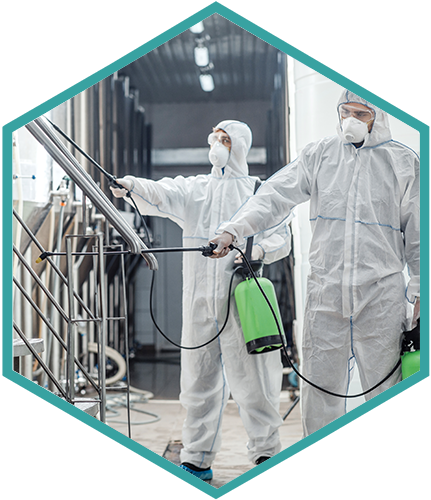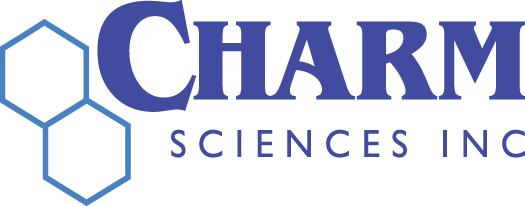Sanitär/Hygiene (ATP) Tests
 Hygiene ist ein wesentlicher Faktor für die Lebensmittelsicherheit, das Gesundheitswesen, das Gastgewerbe und andere Branchen. In lebensmittelverarbeitenden Betrieben können unerwünschte, mikroskopisch kleine Substanzen das Aussehen, den Geschmack und die Sicherheit von Lebensmitteln verändern. Ebenso können in Gesundheitseinrichtungen unerwünschte Mikroorganismen in Patientenzimmern oder auf chirurgischen Geräten Infektionen verbreiten.
Hygiene ist ein wesentlicher Faktor für die Lebensmittelsicherheit, das Gesundheitswesen, das Gastgewerbe und andere Branchen. In lebensmittelverarbeitenden Betrieben können unerwünschte, mikroskopisch kleine Substanzen das Aussehen, den Geschmack und die Sicherheit von Lebensmitteln verändern. Ebenso können in Gesundheitseinrichtungen unerwünschte Mikroorganismen in Patientenzimmern oder auf chirurgischen Geräten Infektionen verbreiten.
Charm Sciences bietet ATP-Tests an, mit denen Kunden die Sauberkeit auf mikroskopischer Ebene schnell, kostengünstig und objektiv überprüfen können. Diese Tests werden innerhalb von Sekunden durchgeführt und ermöglichen bei Bedarf sofortige Abhilfemaßnahmen.
Vorteile
-
-
- Schnelle Ergebnisse in nur 5 Sekunden.
- Überlegene Empfindlichkeit mit der novaLUM II-X-Technologie.
- Überprüfung von nassen und trockenen Oberflächen.
- Integrated data management software to track, trace, and trend results.
-
-
-
- Tupfer sind bei Raumtemperatur bis zu 12 Monate lang stabil.
- Recycelbare Komponenten für weniger Abfall.
-
PRODUKTE UMFASSEN:
PocketSwab Plus ATP Swab (Überprüfung der Oberflächenhygiene)
Der PocketSwab Plus ATP-Schnelltest (Adenosintriphosphat) ist ein bei Raumtemperatur stabiler, in sich geschlossener Einzeltest, der eine vollständige Überprüfung der Oberflächenhygiene in nur 5 Sekunden ermöglicht und Korrekturmaßnahmen in Echtzeit erlaubt. Der PocketSwab Plus ATP swab wird zur Überprüfung der Reinigung und zur Validierung von Sanitär- und Hygienepraktiken eingesetzt, um Kreuzkontaminationen und mikrobielle Herausforderungen aufgrund ineffektiver Sanitärverfahren zu vermeiden. Die Daten werden für die HACCP-Dokumentation und für Audits zur Lebensmittelsicherheit gesammelt, verfolgt und ausgewertet.
WaterGiene ATP Swab (Überprüfung der Wasserhygiene)
Der WaterGiene ATP swab wird verwendet, um die Hygiene von Wasser zu testen, einschließlich CIP-Wasser, Spülwasser und Kühlwasser. Der WaterGiene swab misst die Wasserreinheit in 20 Sekunden durch Messung des Gesamt-ATP. Hohe ATP-Werte weisen darauf hin, dass Mikroorganismen, Lebensmittel und andere biologische Stoffe im Wasser vorhanden sind.
AllerGiene ATP Swab (Allergenkontrolle)
AllerGiene ATP swab ist ein ATP-basierter Allergenkontrolltest, der entwickelt wurde, um Kreuzkontakte mit allergenen Lebensmittelverschmutzungen auf Prozessanlagen zu verhindern. Er misst ATP (Adenosintriphosphat) in niedrigen Konzentrationen als Indikator für das Vorhandensein von Lebensmitteln auf nass gereinigten Oberflächen oder Spülwasser. Der AllerGiene swab ist ein einfacher 20-Sekunden-Test mit ausreichend hoher Empfindlichkeit für allergene Lebensmittelrückstände. Der Tupfer erreicht Nachweise, die mit spezifischen Allergenmethoden vergleichbar sind - 0,1 bis 25 ppm für die meisten der acht allergenen Lebensmittelgruppen: Erdnussbutter, Weizen, Sojabohnen, Krustentiere (Garnelen), Milch, Baumnüsse, Ei und Sesam.
FieldSwab ATP Swab (Überwachung der Außenhygiene)
Mit dem FieldSwab ATP swab können Programme zur Lebensmittelsicherheit im Freien durchgeführt werden. Wie der PocketSwab Plus ATP swab weist der FieldSwab-Test schnell ATP (Adenosintriphosphat) als Maß für die Oberflächenreinheit nach. Dies geschieht durch Messung der Lichteinheiten, die bei der Reaktion von ATP mit Luciferin/Luciferase entstehen. Der FieldSwab-Test ist mit einer lichtundurchlässigen Abdeckung versehen, um Störungen durch Tageslicht zu verhindern, und verwendet einen speziell kalibrierten Kanal des novaLUM II-X-Systems.
novaLUM II-X System (Luminometer)
Das novaLUM II-X System ist ein handtellergroßes Luminometer, das überlegene Wissenschaft für fortschrittliche Hygienekontrolle bietet. Es nutzt eine technologisch fortschrittliche Photomultiplier-Röhre (PMT), die ATP (Adenosintriphosphat) verstärkt und so den Nachweis geringerer Mengen an mikrobieller und organischer Verunreinigung ermöglicht.

Branchen
Warum sollten Sie sich für die ATP-Tests und -Ausrüstung von Charm entscheiden?
Charm Sciences bietet ein branchenführendes ATP-Hygieneüberwachungssystem an, das sich in Bezug auf die Auswirkungen von Temperatur und Zeit auf die Wiederholbarkeit und Genauigkeit der Testergebnisse von anderen abhebt. Wir erhalten Validierungen durch enge Zusammenarbeit mit den Aufsichtsbehörden und haben uns einen einen Ruf als Diagnostik-Lieferant der ersten Wahl weltweit.
Wir bieten ein hochempfindliches ATP-Überwachungssystem an, das Herstellern und Prüfern in verschiedenen Branchen hilft, den Grad der Produktreinheit zu bestimmen. Unser System kombiniert drei wesentliche Komponenten - das Design des Testgeräts, die Biolumineszenz-Chemie und das Luminometer - um die anderen zu übertreffen.
Wir bieten hochmoderne, kundenspezifische Photomultiplier (PMTs) zum Nachweis von ATP an. Diese Geräte sind lichtempfindlicher als andere Geräte, nämlich Fotodioden. Da der minimale nachweisbare Lichtpegel bei PMTs viel niedriger ist als bei anderen Geräten, eignen sie sich besser für den Nachweis von ATP.
Kontakt Vertrieb
Haben Sie eine Frage zum Verkauf? Senden Sie uns eine Nachricht und ein Vertriebsmitarbeiter wird sich mit Ihnen in Verbindung setzen.
By submitting your information via this form, you give Charm Sciences permission to contact you via email about updates, news, or offers that may interest you. It is Charm Sciences’ policy not to share any personally-identifying material obtained through our websites with any third party.
